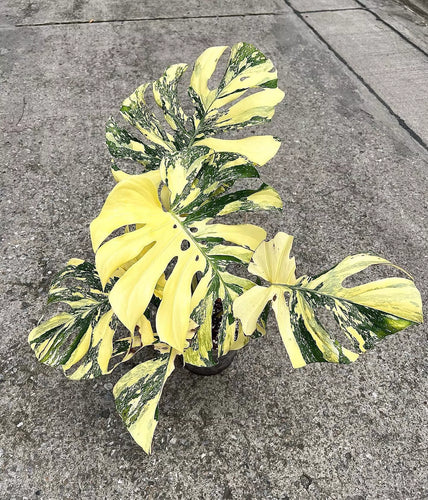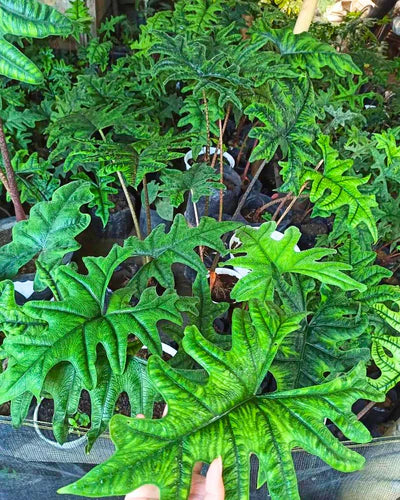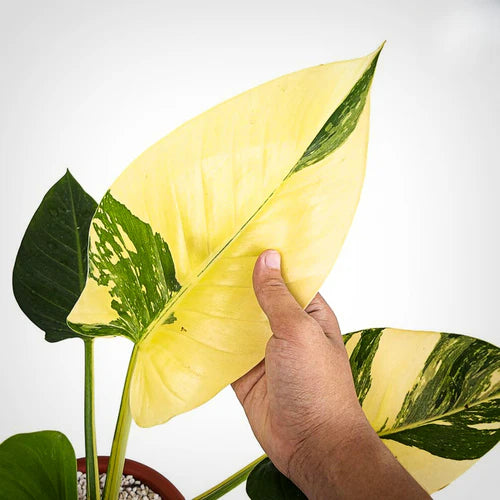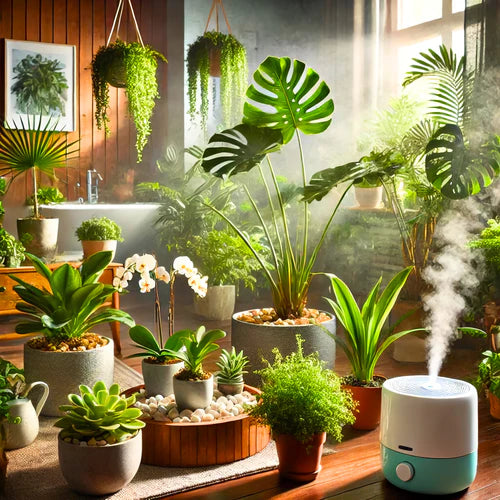What are the Best Tropical Plants for Indoors?
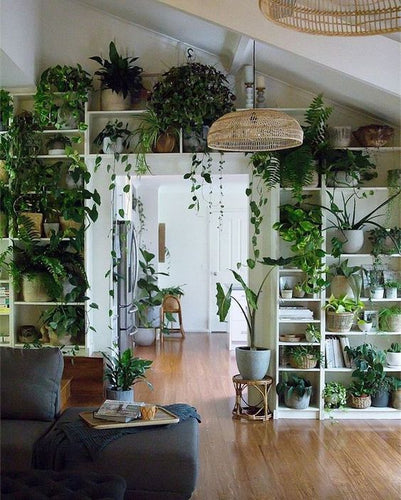
The best tropical plants for indoors do more than just add beauty to your space—they bring real benefits to your home. These lush, vibrant plants are natural air purifiers, working quietly to remove toxins and improve air quality. Plus, having these gorgeous greens around can lift your spirits and help create a more relaxing, stress-free environment. A new leaf you say?
Table of Contents
- Introduction
- Why Choose Tropical Plants for Your Home?
- Top 5 Easy-to-Care Tropical Indoor Plants
- Essential Items for Tropical Houseplant Care
- Growing Requirements for Thriving Indoor Plants
- How to Choose the Right Pot and Soil
- Humidity and Watering Needs
- Sunlight and Artificial Light Options
- Common Pests and How to Fight Them
- Fertilization and Plant Food
- Best Practices for Pruning and Repotting
- Climbing Plants and Supporting Structures
- Recommendations for Specific Rooms in Your Home
- Frequently Asked Questions
- Where to Buy Tropical Plants for Sale
Introduction
Transforming your home into a tropical paradise is easier than you think, especially when you have the right indoor tropical plants. Whether you're looking to add a few statement pieces or create an entire indoor tropical garden, these plants bring life, color, and an exotic touch to any room. In this guide, we’ll cover everything you need to know about selecting, caring for, and thriving with tropical house plants in your home.
Why Choose Tropical Plants for Your Home?
Tropical plants are not just beautiful; they are also beneficial for your indoor environment. Many of these plants are natural air purifiers, helping to remove toxins and improve air quality. Additionally, the lush greenery and vibrant colors of tropical indoor plants can boost your mood and reduce stress levels.
Key Benefits of Tropical Indoor Plants:
- Air Purification: Plants like the Snake Plant and Monstera Deliciosa are known for their air-purifying abilities.
- Aesthetic Appeal: The wide variety of leaf shapes, colors, and sizes add visual interest to your home.
- Mood Enhancement: Being surrounded by greenery can reduce stress and increase feelings of well-being.
Top 5 Easy-to-Care Tropical Indoor Plants
Starting with easy-to-care-for plants is a great way to ensure success in your indoor tropical garden. Here are five top picks that thrive indoors with minimal effort:
1. Monstera Deliciosa
Known for its large, perforated leaves, the Monstera Deliciosa is a striking plant that grows well in indirect light. It's relatively low-maintenance, requiring only occasional watering and a well-draining potting mix.
2. Snake Plant (Sansevieria)
The Snake Plant, often referred to as one of the best indoor plants for beginners, is virtually indestructible. It can tolerate low light and infrequent watering, making it an ideal choice for busy or forgetful plant parents. Learn more about the Snake Plant here.
3. ZZ Plant (Zamioculcas zamiifolia)
With its glossy leaves and robust nature, the ZZ Plant is perfect for low-light conditions. It’s also drought-tolerant, requiring watering only when the soil is completely dry.
4. Philodendron
Philodendrons are versatile and easy to care for. They thrive in moderate light and need to be watered when the top inch of soil is dry. With many varieties available, there's a Philodendron for every style.
5. Pothos (Epipremnum aureum)
Pothos is one of the most forgiving tropical house plants. It can survive in a range of light conditions and only needs water when the soil starts to dry out.
Looking for rare and unique houseplants? Check out our guide on 8 Rare Aglaonema Houseplants.
Essential Items for Tropical Houseplant Care
To maintain a thriving indoor tropical garden, certain tools and products are essential. These items will ensure your plants receive the care they need to flourish.
Must-Have Care Items:
- Well-Draining Soil Mix: A specialized aroid mix works best for many tropical plants.
- Humidifier: Tropical plants thrive in humid conditions. A quality humidifier can help maintain the necessary humidity levels.
- Moisture Meter: Avoid overwatering by using a moisture meter to check soil moisture.
- Grow Lights: Supplement natural light with grow lights, especially in rooms with limited sunlight.
- Fertilizer: Slow-release fertilizers provide essential nutrients over time.
- Light Meter: Ensure your plants are receiving adequate light by measuring natural and artificial light levels.
- Pest Control: Keep pests at bay with neem oil or insecticidal soap.
- Support Structures: Use clear moss poles or trellises for climbing plants.
These tools are not just nice-to-haves; they are crucial for the ongoing health of your indoor tropical plants.
Growing Requirements for Thriving Indoor Plants
Success with tropical indoor plants hinges on understanding their specific growing requirements. While each plant may have its unique needs, there are general guidelines that apply to most tropical house plants.
Light Requirements:
- Indirect Light: Most tropical plants prefer bright, indirect light. Direct sunlight can scorch their leaves.
- Artificial Light: If natural light is scarce, use grow lights to mimic sunlight.
Watering Needs:
- Consistency is Key: Water when the top inch of soil feels dry, but avoid waterlogging.
- Humidity: Tropical plants love humidity, so consider using a humidifier or placing a tray of water near your plants to increase moisture in the air.
Soil and Fertilization:
- Well-Draining Soil: Use a soil mix that drains well to prevent root rot. Adding perlite or orchid bark can improve aeration.
- Fertilization: During the growing season (spring and summer), apply a slow-release fertilizer or organic compost.
How to Choose the Right Pot and Soil
Choosing the right pot and soil mix is crucial for the health of your tropical plants. The pot should have adequate drainage to prevent water from accumulating at the bottom, which can lead to root rot.
Pot Selection:
- Drainage Holes: Ensure your pot has drainage holes to allow excess water to escape.
- Size Matters: Choose a pot that’s just one or two sizes larger than the current root ball to encourage healthy growth.
Soil Mix:
- Well-Draining Soil: A mix containing peat, perlite, and orchid bark works well for most tropical plants.
- Specialized Mix: For aroids like Monstera and Philodendron, use a specialized aroid mix for optimal growth.
Humidity and Watering Needs
Tropical plants thrive in humid environments, so replicating this indoors is key to their success.
Humidity:
- Ideal Levels: Aim for 50-60% humidity for most tropical plants.
- Using a Humidifier: A humidifier can help maintain consistent humidity levels, especially during dry winter months.
Watering Tips:
- Check Soil Moisture: Use a moisture meter to determine when your plants need water. Water thoroughly until it drains out of the pot’s bottom, but don’t let the plant sit in standing water.
- Adjust for Season: Water less frequently during the dormant winter months.
Sunlight and Artificial Light Options
Light is one of the most critical factors for the growth of tropical plants. However, not all plants require the same amount of light.
Natural Light:
- Bright, Indirect Light: Place your plants near windows with filtered light. Avoid direct sun, which can burn the leaves.
- East or North-Facing Windows: These windows typically offer the right amount of indirect light for most tropical plants.
Artificial Light:
- Grow Lights: If natural light is insufficient, invest in LED grow lights to supplement your plants’ needs. Position them 12-24 inches above the plants.
Common Pests and How to Fight Them
Even well-cared-for indoor plants can attract pests. It’s essential to act quickly at the first sign of an infestation.
Common Pests:
- Spider Mites: These tiny pests can cause leaves to yellow and drop.
- Aphids: Small, green insects that feed on plant sap, causing stunted growth.
- Mealybugs: White, cotton-like pests that cluster on stems and leaves.
Pest Control Solutions:
- Neem Oil: A natural solution effective against a variety of pests.
- Insecticidal Soap: Safe for indoor use, this can be sprayed directly on affected plants.
- Regular Inspection: Check your plants regularly for signs of pests, particularly under the leaves where they like to hide.
Fertilization and Plant Food
Providing the right nutrients is essential for the healthy growth of your tropical indoor plants.
Types of Fertilizer:
- Slow-Release Fertilizer: Offers a steady supply of nutrients over time, reducing the need for frequent feeding.
- Organic Options: Compost or worm castings can enrich the soil naturally.
When to Fertilize:
- Growing Season: Fertilize during the spring and summer when plants are actively growing.
- Avoid Over-Fertilizing: Excess fertilizer can burn plant roots and cause leaf discoloration.
Best Practices for Pruning and Repotting
Pruning and repotting are vital for maintaining the health and appearance of your tropical plants.
Pruning:
- Encourages Growth: Regular pruning helps plants grow bushier and prevents them from becoming leggy.
- Remove Dead Leaves: Cut away any yellowing or dead leaves to keep the plant looking its best.
Repotting:
- Signs You Need to Repot: When roots begin to grow out of the pot’s drainage holes, it’s time to repot.
- Choose the Right Time: The best time to repot is in the spring or early summer, during the plant’s active growth period.
Climbing Plants and Supporting Structures
Many tropical plants are natural climbers, and providing them with the right support can help them thrive.
Supporting Structures:
- Clear Moss Poles: Ideal for plants like Monstera, clear moss poles support climbing while blending with your décor.
- Trellises: These can be used for trailing plants like Philodendron to encourage upward growth.
Recommendations for Specific Rooms in Your Home
Different tropical plants thrive in various rooms based on light and humidity levels.
Living Room: Monstera Deliciosa
The spacious living room is perfect for a large statement plant like the Monstera Deliciosa. Its bold, perforated leaves create a stunning focal point.
Bathroom: Snake Plant
Bathrooms typically have higher humidity, making them ideal for the Snake Plant. It thrives in low light and can handle the moisture-rich environment.
Bedroom: Aglaonema
For a bedroom, the Aglaonema is an excellent choice. It’s easy to care for and has a calming presence, making it perfect for a restful space.
Frequently Asked Questions - Indoor Tropical Plants
What is the easiest tropical plant to grow indoors?
The ZZ Plant, or Zamioculcas zamiifolia, is widely recognized as one of the easiest tropical plants to grow indoors. Its resilience makes it a favorite among both novice and experienced plant owners. The ZZ Plant is highly tolerant of low light conditions, making it suitable for spaces with minimal natural light. Additionally, it has a remarkable ability to store water in its rhizomes, which means it can thrive with infrequent watering. This drought tolerance, coupled with its resistance to common pests, makes the ZZ Plant an ideal choice for anyone looking to enjoy the beauty of tropical plants without the high maintenance.
Are tropical plants good houseplants?
Yes, tropical plants are not only good but exceptional houseplants for a variety of reasons. Beyond their aesthetic appeal, which includes vibrant colors, unique leaf shapes, and lush foliage, tropical plants also offer significant health benefits. Many tropical species are known for their air-purifying properties, removing harmful toxins such as formaldehyde, benzene, and trichloroethylene from the air. This makes them a functional addition to your home, contributing to improved indoor air quality. Moreover, the presence of tropical plants in your living space can enhance your mental well-being, reducing stress and creating a calming atmosphere that mimics the serene environment of a natural tropical habitat.
How often should you water indoor tropical plants?
The watering needs of indoor tropical plants can vary based on several factors, including the specific type of plant, the composition of the soil, the level of humidity in your home, and the amount of light the plant receives. As a general rule, tropical plants prefer to be kept in consistently moist soil, but it’s important to avoid waterlogging, which can lead to root rot. The best practice is to water when the top inch of soil feels dry to the touch. During the growing season (spring and summer), you may need to water more frequently, while in the dormant winter months, reduce watering to prevent over-saturation. Using a moisture meter can help you accurately assess the soil’s moisture level and adjust your watering schedule accordingly.
Should you mist indoor tropical plants?
Misting is a common practice for maintaining the humidity levels that tropical plants need to thrive indoors. Most tropical plants originate from environments with high humidity, and indoor air, especially during winter, can be much drier than they prefer. Regular misting helps increase the humidity around the plant, which is particularly beneficial for species with large, broad leaves like Monstera or Calathea. However, it’s important to mist in the morning to allow the leaves to dry throughout the day, as consistently wet foliage can lead to fungal diseases. For optimal results, combine misting with the use of a humidifier or place your plants on a tray filled with pebbles and water to maintain a consistently moist micro-environment.
Do tropical plants do well indoors?
Tropical plants can indeed thrive indoors if their environmental needs are met. The key to their success lies in replicating the conditions of their natural habitats as closely as possible. This means providing them with adequate light—preferably bright, indirect sunlight—maintaining consistent humidity levels, and ensuring they are kept at a stable, warm temperature. Many tropical plants are adaptable and can adjust to the indoor environment, making them an excellent choice for indoor gardening. However, attention to detail in their care routine is essential to keep them healthy and vibrant.
Are tropical plants hard to care for?
Tropical plants are not inherently difficult to care for, but they do require specific conditions that mimic their native environments. When these conditions—such as light, humidity, and temperature—are carefully managed, tropical plants can be quite easy to maintain. For example, plants like the Snake Plant and ZZ Plant are incredibly low-maintenance, thriving with minimal water and light. The challenge often comes from the need to maintain higher humidity levels and consistent warmth, especially during the colder months. By understanding the natural conditions each species requires and making adjustments in your indoor environment, you can enjoy the lush beauty of tropical plants with relative ease.
How do I keep my tropical plants warm during winter?
Keeping tropical plants warm during the winter months is crucial for their survival and continued growth. Tropical plants are sensitive to cold and can suffer damage if exposed to temperatures below 50°F (10°C). To keep your plants warm, first, ensure they are placed away from drafty windows, doors, or vents where cold air might reach them. You can also use insulating materials like bubble wrap around pots to protect the roots from the cold. Additionally, consider using a space heater in the room where your plants are kept, but be careful not to place the heater too close to the plants to avoid overheating. Heat mats can also be beneficial, especially for plants that are sensitive to root temperature. Finally, maintaining a consistent indoor temperature and monitoring it with a thermometer can help ensure your tropical plants stay cozy during the winter.
What are the best small indoor tropical plants?
For those with limited space, small indoor tropical plants can still provide the lush, exotic feel of the tropics without overwhelming your home. Some of the best small tropical plants include:
- Peperomia: With its compact size and variety of leaf shapes and colors, Peperomia is a great choice for tabletops and small spaces. It’s low-maintenance and thrives in indirect light.
- Calathea: Known for its striking leaf patterns, Calathea is a small plant that prefers high humidity and indirect light. Its decorative foliage makes it a popular choice for adding visual interest to small areas.
- Mini Monstera (Rhaphidophora tetrasperma): Despite its smaller size, the Mini Monstera offers the iconic split leaves of its larger relative, the Monstera Deliciosa. It’s perfect for small corners or hanging baskets.
- Fittonia (Nerve Plant): Fittonia’s colorful, veined leaves make it a standout in small planters. It loves humidity and indirect light, making it ideal for bathrooms or terrariums.
- Aglaonema: A slow-growing plant with beautiful, variegated leaves, Aglaonema is well-suited to low-light conditions and can remain compact, making it perfect for desks or shelves.
These small tropical plants are perfect for adding a touch of greenery to any room, even when space is at a premium.
Where to Buy Tropical Plants for Sale
There are plenty of options available when it comes to purchasing tropical plants, whether you're a seasoned plant parent or just starting your indoor garden. You can find a wide range of tropical plants at local nurseries or purchase them online from reputable stores. When shopping for tropical houseplants, consider essential factors like plant variety, customer reviews, and guarantees on plant health before making a purchase. It's crucial to choose plants that will thrive in your specific environment and meet your aesthetic preferences.
If you're searching for unique and exotic options, exploring rare tropical plants online can be a rewarding experience. For example, if you’re looking for a classic tropical plant with bold, iconic foliage, you can’t go wrong with a Monstera Deliciosa, which is available for purchase online. The Monstera, with its distinctive split leaves, not only adds visual interest to your space but also thrives in indoor conditions, making it a popular choice among indoor gardeners.
Wrapping Up: Your Ultimate Tropical Indoor Garden
Creating a tropical indoor garden is not just a way to beautify your home; it's also a rewarding hobby that offers numerous benefits. By choosing the right plants, using the proper tools, and understanding their care needs, you can enjoy a thriving indoor jungle that brings a piece of the tropics into your everyday life. Whether you're new to plant care or an experienced green thumb, these tips will help you create and maintain the tropical paradise of your dreams. Happy planting!


